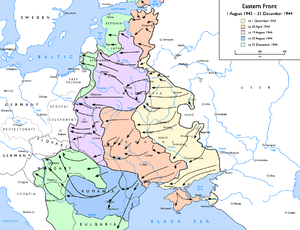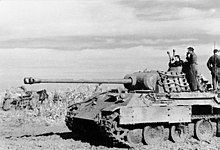Baltic offensive
| Baltic offensive (1944) (Baltic strategic offensive) | |||||||
|---|---|---|---|---|---|---|---|
| Part of the Eastern Front of World War II | |||||||
 Soviet advances on the Eastern Front, 1 August 1943 – 31 December 1944 | |||||||
| |||||||
| Belligerents | |||||||
|
|
| ||||||
| Commanders and leaders | |||||||
|
|
Johannes Freißner | ||||||
| Strength | |||||||
|
1,546,400 troops[1] 17,500 artillery pieces 3,080 tanks and assault guns 2,640 aircraft[2] |
342,742 troops [3] unknown artillery pieces 262 tanks; 299 assault guns 321 aircraft [4] | ||||||
| Casualties and losses | |||||||
| 61,468 | 30,834 KIA, WIA and MIA[5] | ||||||
The Baltic offensive, also known as the Baltic strategic offensive,
Background
By early 1944, the
By 5 July, the
The German reaction was rapid, and initially successful. A counterattack, code-named
Battles

In common with other Soviet strategic offensives, the Baltic offensive covers a number of operational level operations and individual Front offensive operations:[8]
- The Riga offensive (Russian: Рижская наступательная операция) (14 September–24 October 1944) was carried out by the 3rd and 2nd Baltic Fronts and cleared the eastern coast of the Gulf of Riga.
- The Tallinn offensive (Russian: Таллинская наступательная операция) (17–26 September 1944) was carried out by the Leningrad Front to drive German forces from mainland Estonia.
- The Moonsund Landing Operation (Russian: Моонзундская десантная операция) (27 September–24 November 1944) was the amphibious landing on the Estonian islands of Hiiumaa, Saaremaa and Muhu, which block access to the Gulf of Riga. According to Soviet data Germany lost 7,000 dead soldiers and 700 captured.[9]
- The Memel offensive (Russian: Мемельская операция) (5–22 October 1944) was an attack by the 1st Baltic Front aimed at severing the connection between the German Army Groups Centre and North.
From the German defensive perspective, the period included the following operations:
- Operation Cäsar, aimed at the restoration of contact between Army Groups Centre and North 16–21 September 1944;
- Operation Asteraimed at the evacuation of Army Group North from mainland Estonia 17–26 September 1944;
- The siege of Memel 5–27 October 1944;
- Formation of the Courland Pocket 15–22 October 1944.
Aftermath

Soviet victory
The Baltic offensive operation resulted in the expulsion of German forces from Estonia and Lithuania. The Soviet fronts involved in the battle lost a total of ca. 280,000 men to all causes (killed, missing, wounded, sick).
Communication lines between Army Group North and Army Group Centre were permanently severed, and the former was relegated to an occupied Baltic seashore area in Latvia. On 25 January, Adolf Hitler renamed Army Group North to Army Group Courland implicitly recognising that there was no possibility of restoring a new land corridor between Courland and East Prussia.[10] The Red Army commenced the encirclement and reduction of the Courland Pocket which retained a possibility of being a major threat, but were able to focus on operations on its northern flank that were now aiming at East Prussia. Operations by the Red Army against the Courland Pocket continued until the surrender of the Army Group Courland on 9 May 1945, when close to 200,000 Germans were taken prisoner there.
The German command released thousands of native conscripts from military service. However the Soviet command began conscripting Baltic natives as areas were brought under Soviet control.
112 Hero of the Soviet Union awards were given out during the offensive, of which three were given soldier's second award.[11]
Reoccupation of the Baltic states

Soviet rule of the Baltic states was re-established by force, and
Formations and units involved
Soviet
- 1st Baltic Front commanded by General Ivan Bagramyan
- 5th Guards Tank Army commanded by General Vasily Volsky
- 6th Guards Army commanded by Lieutenant-General Ivan Chistyakov
- 4th Shock Army commanded by Lieutenant-General Pyotr Malyshev
- 43rd Army commanded by Lieutenant-General Afanasy Beloborodov
- 51st Army commanded by Lieutenant-General Yakov Kreizer
- 33rd Army commanded by Lieutenant-General Vyacheslav Tsvetayev
- 3rd Air Army
- 2nd Baltic Front commanded by Army-General Andrey Yeryomenko
- 3rd Shock Army commanded by Lieutenant-General Nikolai Simoniak
- 22nd Army commanded by Lieutenant-General Vladimir Vostrukhov
- 3rd Baltic Front commanded by Colonel-General I.I. Maslennikov
- 3rd Belorussian Front (parts) commanded by Army General Ivan Chernyakhovsky
- 2nd Shock Army commanded first by Lieutenant-General Porfiry Chanchibadze, then by Lieutenant-General Ivan Fedyuninsky
- 3rd Guards Mechanized Corps commanded by Lieutenant-General Viktor Obukhov
- Pavel Belov
- Vladimir Sviridov
- Leningrad Front commanded by Marshal L.A. Govorov (parts)
- 8th Army commanded by Lieutenant-General Filipp Starikov
German
- Army Group North commanded by Colonel-General Ferdinand Schörner
- Army detachment "Narwa" commanded by Infantry General Grasser
- Eighteenth Army commanded by Infantry-General Loch
- Sixteenth Army commanded by Artillery-General Hansen
- 502nd Heavy Panzer Battalion
- Army Group Centre commanded by Colonel-General Reinhardt
- Third Panzer Army commanded by Colonel-General Erhard Raus
- XXXX Panzer Corps
- XXXIX Panzer Corps
- Panzer Grenadier Division Grossdeutschland
- 4th Panzer Division
- 5th Panzer Division
- 17th Panzer Division
- Third Panzer Army commanded by Colonel-General Erhard Raus
Notes and references
- ^ a b Soviet casualties and combat losses in the twentieth century London: Greenhill Books 1997
- ^ Frieser, Karl-Heinz; Schmider, Klaus; Schönherr, Klaus; Schreiber, Gerhard; Ungváry, Kristián; Wegner, Bernd The Eastern Front 1943–1944: The War in the East and on the Neighbouring Fronts, p. 636
- ^ Frieser, Karl-Heinz, p. 622
- ^ Frieser, Karl-Heinz, p. 636
- ^ Frieser, p. 641
- ^ Anderson, p. 203; Muriev, pp. 22–28; Stilwell, p. 343; Проэктор.
- ^ a b Д. Муриев, Описание подготовки и проведения балтийской операции 1944 года, Военно-исторический журнал, сентябрь 1984. Translation available, D. Muriyev, Preparations, Conduct of 1944 Baltic Operation Described, Military History Journal (USSR Report, Military affairs), 1984-9, pp. 22–28
- ^ See soldat.ru Archived May 5, 2008, at the Wayback Machine for a breakdown of the strategic offensive
- ^ "Основные операции Советских Вооруженных Сил в ВОВ, начавшиеся в 1944 году". militarymaps.narod.ru.
- ^ On 25 January, Hitler renamed three army groups: Army Group North became Army Group Courland; Army Group Centre became Army Group North and Army Group A became Army Group Centre
- ^ "KM.RU - новости, экономика, автомобили, наука и техника, кино, музыка, спорт, игры, анекдоты, курсы валют | KM.RU". www.km.ru.
- Estonian International Commission for the Investigation of Crimes Against Humanity, pp. VII–XXVI. Tallinn, 2009
- Anderson, D, et al. The Eastern Front, Zenith Imprint (2001), ISBN 0-7603-0923-X
- Muriyev, D. Preparations, Conduct of 1944 Baltic Operation Described, Military History Journal (USSR Report, Military affairs), 1984-9
- Stilwell, A. and Hastings, M. The Second World War: A World in Flames, Osprey (2004), ISBN 1-84176-830-8
- Проэктор, Д. M. "Агрессия и катастрофа. Высшее военное руководство фашистской Германии во второй мировой войне", Глава восьмая. "Катастрофа", М.: Наука, 1972.
Further reading
- Melzer, W. 'Der Kampf um die baltischen Inseln'
- Niepold, G. 'Panzeroperationen Doppelkopf und Cäsar'
- Ziemke, E.F. 'Stalingrad to Berlin'
- Bagramyan 'So schritten wir zum Sieg'
External links
 Media related to Baltic Offensive at Wikimedia Commons
Media related to Baltic Offensive at Wikimedia Commons
